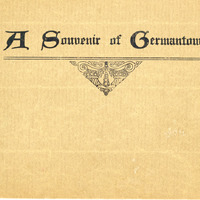-
Title
-
A Souvenir of Germantown Issued during the 50th Anniversary Celebration of the Emancipation Proclamation At Philadelphia, Pa., September, 1913
-
Description
-
The Souvenir is rare and a historically significant photo booklet created and produced by J. Gordon Baugh Jr., a Black printer and civic leader based in Germantown, Philadelphia, PA. It was published in 1913 to coincide with
-
the 50th anniversary of Abraham Lincoln's Emancipation Proclamation and functions as a visual celebration and a political statement about the progress of Germantown’s Black community in the early 20th century.
The booklet consists of captioned photography that highlight institutions, people, homes, churches, and businesses that made up Germantown’s thriving Black community in 1913. There is no narrative text—the images speak for themselves, conveying pride, dignity, and civic engagement. However, a 1984 article written by Louise Strawbridge, provides an “indepth” annotated version of much of the photographs in The Souvenir (Sorrentino and Rosen 2024).
The document expresses themes of community; like leadership, economic self-sufficiency, home ownership and education. There are images of physicians and pastors, of entrepreneurs that represent tailors, barbers and grocers and of students, schools and organizations that showcase educational excellence that embodies pathways to advancement. Churches and their congregations are central, portrayed as anchors of community strength and resilience. Neat, well-kept homes reflect personal dignity and middle-class aspiration. These images counter the supremacist ideology of Black civic exclusion and racist depictions that were common at the time.
In its pages appeared figures like Dr. William Warrick, one of the earliest Black graduates of Penn’s medical school, and John S. Trower, a successful caterer and real estate investor. Churches like Janney Street Methodist Episcopal and Enon Tabernacle Baptist Church stood as architectural testaments to faith and community leadership. Baugh also highlighted the education of Black youth who attended the Joseph E. Hill School and the careful upkeep of homes, all evidence that Germantown’s Black citizens embodied the ideals of American progress while still being denied full societal access to its rewards.
Baugh’s message was layered. Alongside the photography, he included a poem, "A Song of the Times", that spoke to weariness, injustice, and the shadows of slavery and Jim Crow legacies. The poem suggests that the struggle continues, Baugh’s Souvenir resembled the philosophies of both Booker T. Washington—with its themes of uplift and respectability—and W.E.B. Du Bois, who insisted that racism must be confronted head-on (Sorrentino and Rosen 2024).
The breadth and depth of the Black community in early 20th century Germantown and the footprint of its residents – the subject of much of The Souvenir – is richly immense and still unfamiliar. For additional reading one is encouraged to obtain the Spring/Fall 2024 issue of The Germantown Crier, an electronic journal publication of Historic Germantown. It conceptually revisits The Souvenir and conducts additional research and interpretive analysis, authored by Catherine Sorrentino and Charlotte Rosen, PhD.
-
Rights
-
This work is believed to be in the Public Domain under the laws of the United States. For more information, see http://rightsstatements.org/page/NoC-US/1.0/
-
Creator
-
Baugh Press
-
Date
-
1913
-
Format
-
Booklet
-
Language
-
eng
-
Spatial Coverage
-
Germantown, PA
-
Publisher
-
Baugh Press
-
Contributor
-
Historic Germantown
-
Extent
-
42 pages
-
Subject
-
Essay--Authorship
-
Photographic interpretation
-
Photograph captions
-
History--Research
-
Racism
-
Philosophy
-
Black people--Social conditions

